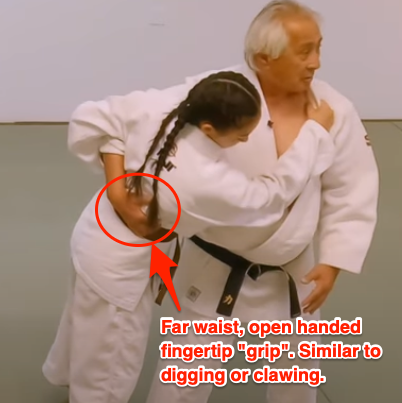Teaching My Teammates: Judo Terms & Concepts (6): O-goshi
This Week’s Quiz
New Terms
None!
Returning Judo Terms
Tori
Uke
Kuzushi
Tsukuri: entry, or “shape” of a throw
Aiyotsu: symmetrical grips (RvR or LvL)
Kenkayotsu: asymmetrical grips (RvL)
O-goshi: big hip
Uki-goshi: floating hip
Koshi-guruma: hip wheel
Tachiwaza: techniques in standing
Returning Biomechanics Terms
See Week 3 to review as needed.
Base: An abbreviation for “base of support.” This is the area beneath all body parts in contact with the ground. In tachiwaza, it is the feet and the area between them.
Center of Mass (CoM): In oversimplified terms, this is a person’s balance point. When standing, a human’s center of mass is just forward of the sacral bone, inside the pelvis. This balance point moves around as body parts do; it is not always at the center of the pelvis.
Kuzushi: “un-balancing.” This is the process of pulling or pushing someone’s weight outside of their feet or creating a situation where one or both feet disconnect from the ground.
O-goshi (大腰)
English name: big hip
Classification: koshi-waza
Kuzushi direction: forward, toward Tori
O-goshi is a hip throw that does not use a traditional sleeve-lapel grip. Tori must use a combination of footwork, fakes/feints, or strikes to gain a grip on Uke’s back. Back grips useful for O-goshi may include: a belt fist grip, back panel fist grip, or far side waist fingertip grip.
Kanō, J. (2013). Kodokan Judo. Kodansha America Inc.
YouTube. (2018, March 1). O-Goshi - Competitive Variations. Efficient Judo YouTube Channel. https://www.youtube.com/watch?v=oXTwNVxaka8
YouTube. (2023, March 20). O-Goshi Tips | Riki Judo Dojo. Riki Judo Dojo YouTube Channel. https://www.youtube.com/watch?v=n6AzG_LvsSU
This back grip is vital to o-goshi. It acts in tandem with Tori’s sleeve grip to form a “hoop” of control around Uke’s trunk. The hoop control works to unify the Uke’s center of mass and Tori’s center of mass (balance points) through connection. Without hoop control of Uke’s trunk, Tori remains disconnected from Uke and the centers of mass do not merge.
YouTube. (2020, July 9). 大腰 / O-goshi. KODOKAN YouTube Channel. https://www.youtube.com/watch?v=yhu1mfy2vJ4
Once hoop control of the trunk is established, Tori steps inside Uke’s feet, just in front of their base. Tori drives their hip underneath Uke and then extends their knees to lift Uke’s center of mass off of the ground. This disconnects Uke from the ground, eliminating their base. As Tori’s hips continue to punch up and into Uke, the hoop control around Uke’s trunk pulls Uke forward to complete the throw.
YouTube. (2020, July 9). 大腰 / O-goshi. KODOKAN YouTube Channel. https://www.youtube.com/watch?v=yhu1mfy2vJ4
YouTube. (2020, July 9). 大腰 / O-goshi. KODOKAN YouTube Channel. https://www.youtube.com/watch?v=yhu1mfy2vJ4
YouTube. (2020, July 9). 大腰 / O-goshi. KODOKAN YouTube Channel. https://www.youtube.com/watch?v=yhu1mfy2vJ4
YouTube. (2020, July 9). 大腰 / O-goshi. KODOKAN YouTube Channel. https://www.youtube.com/watch?v=yhu1mfy2vJ4
Hip Loading in O-goshi vs. Uki-goshi
Tori loads Uke onto the entire rear surface of their hips to execute o-goshi. This differs from uki-goshi, which loads Uke onto the lead hip crest.
YouTube. (2020, July 6). 浮腰 / Uki-goshi. KODOKAN YouTube Channel. https://www.youtube.com/watch?v=bPKwtB4lyOQ
YouTube. (2020, July 6). 浮腰 / Uki-goshi. KODOKAN YouTube Channel. https://www.youtube.com/watch?v=bPKwtB4lyOQ
Hip Loading in O-goshi vs. Koshi-guruma
O-goshi also differs from koshi-guruma. Koshi-guruma uses an overrotation to disconnect at least half of the lead hip to load Uke onto mostly the rear hip crest.
Stevens, T. Koshi Guruma - Nagekomi 2. American Judo. https://www.americanjudo.com/blogs/tachi-waza-techniques/koshi-guruma
YouTube. (2021, April 7). Top 10 Judo Koshi guruma Compilation Highlights | 腰車. Judo Spirit YouTube Channel. https://www.youtube.com/watch?v=JgIaC4x9IgQ
YouTube. (2021, April 7). Top 10 Judo Koshi guruma Compilation Highlights | 腰車. Judo Spirit YouTube Channel. https://www.youtube.com/watch?v=JgIaC4x9IgQ













